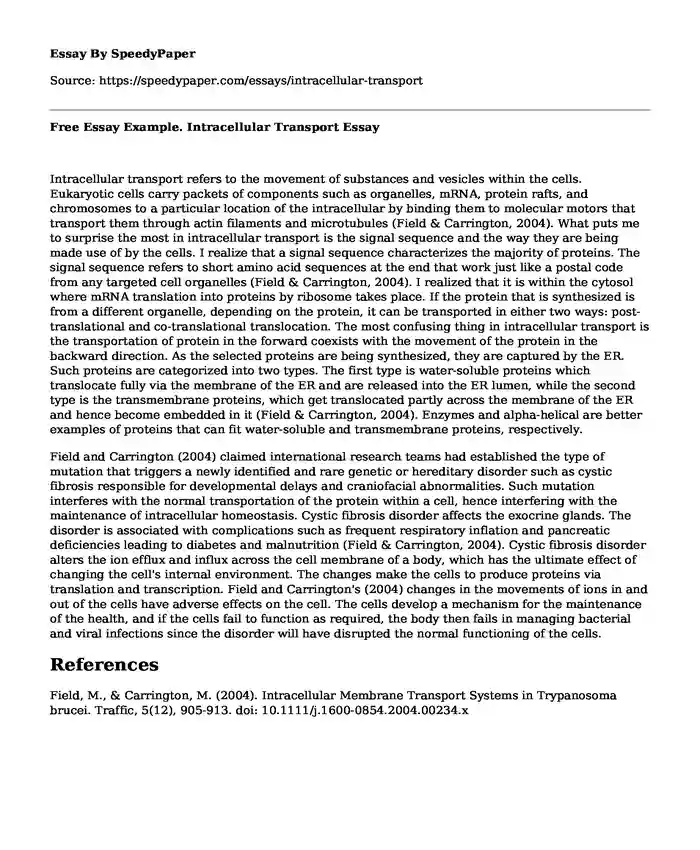Intracellular transport refers to the movement of substances and vesicles within the cells. Eukaryotic cells carry packets of components such as organelles, mRNA, protein rafts, and chromosomes to a particular location of the intracellular by binding them to molecular motors that transport them through actin filaments and microtubules (Field & Carrington, 2004). What puts me to surprise the most in intracellular transport is the signal sequence and the way they are being made use of by the cells. I realize that a signal sequence characterizes the majority of proteins. The signal sequence refers to short amino acid sequences at the end that work just like a postal code from any targeted cell organelles (Field & Carrington, 2004). I realized that it is within the cytosol where mRNA translation into proteins by ribosome takes place. If the protein that is synthesized is from a different organelle, depending on the protein, it can be transported in either two ways: post-translational and co-translational translocation. The most confusing thing in intracellular transport is the transportation of protein in the forward coexists with the movement of the protein in the backward direction. As the selected proteins are being synthesized, they are captured by the ER. Such proteins are categorized into two types. The first type is water-soluble proteins which translocate fully via the membrane of the ER and are released into the ER lumen, while the second type is the transmembrane proteins, which get translocated partly across the membrane of the ER and hence become embedded in it (Field & Carrington, 2004). Enzymes and alpha-helical are better examples of proteins that can fit water-soluble and transmembrane proteins, respectively.
Field and Carrington (2004) claimed international research teams had established the type of mutation that triggers a newly identified and rare genetic or hereditary disorder such as cystic fibrosis responsible for developmental delays and craniofacial abnormalities. Such mutation interferes with the normal transportation of the protein within a cell, hence interfering with the maintenance of intracellular homeostasis. Cystic fibrosis disorder affects the exocrine glands. The disorder is associated with complications such as frequent respiratory inflation and pancreatic deficiencies leading to diabetes and malnutrition (Field & Carrington, 2004). Cystic fibrosis disorder alters the ion efflux and influx across the cell membrane of a body, which has the ultimate effect of changing the cell's internal environment. The changes make the cells to produce proteins via translation and transcription. Field and Carrington's (2004) changes in the movements of ions in and out of the cells have adverse effects on the cell. The cells develop a mechanism for the maintenance of the health, and if the cells fail to function as required, the body then fails in managing bacterial and viral infections since the disorder will have disrupted the normal functioning of the cells.
References
Field, M., & Carrington, M. (2004). Intracellular Membrane Transport Systems in Trypanosoma brucei. Traffic, 5(12), 905-913. doi: 10.1111/j.1600-0854.2004.00234.x
Cite this page
Free Essay Example. Intracellular Transport. (2023, Mar 29). Retrieved from https://speedypaper.com/essays/intracellular-transport
Request Removal
If you are the original author of this essay and no longer wish to have it published on the SpeedyPaper website, please click below to request its removal:
- Free Essay on Equity Employment Program
- Alternative Medicine Vs Modern Medicine Essay Example
- Free Essay on the Movie Fight Club Research
- Essay Example: Health Informatics in the Research Settings and HCO
- Essay Example Comprising the Policy Analysis Speech
- Technology: Blessing or Curse in Health Care Costs? - Essay Sample
- Rural Areas: Diversity, Poverty, and Unique Experiences - Paper Example
Popular categories





